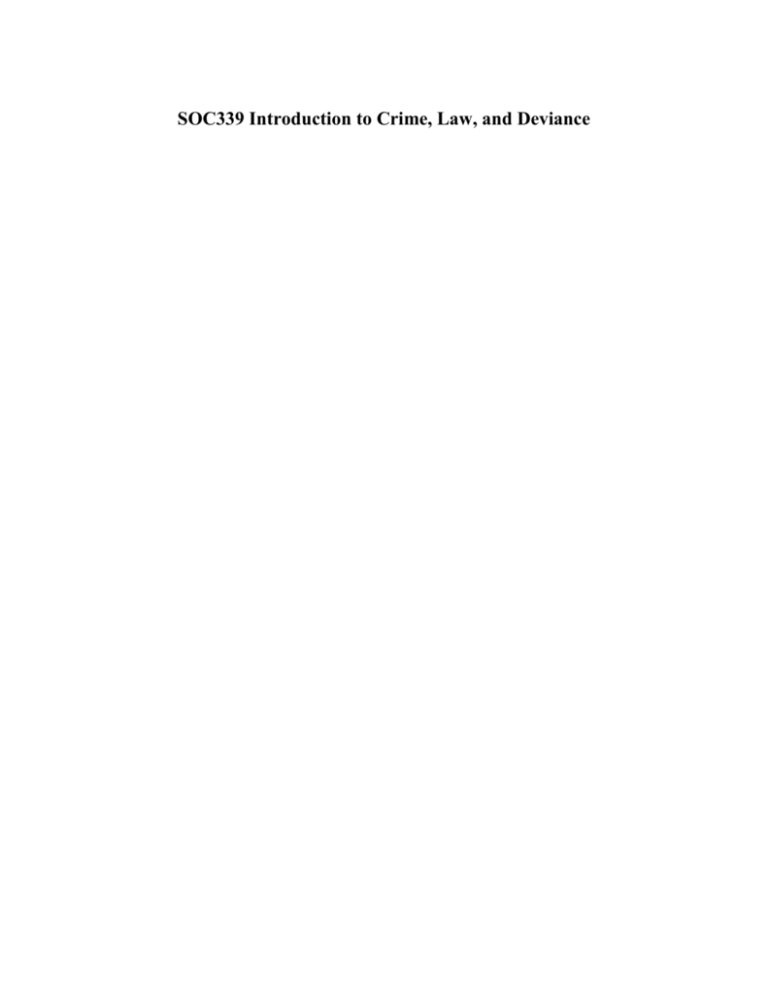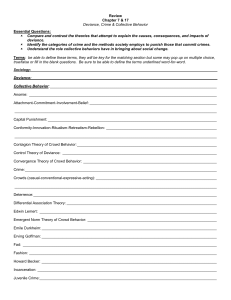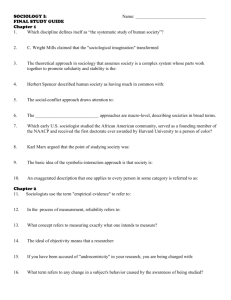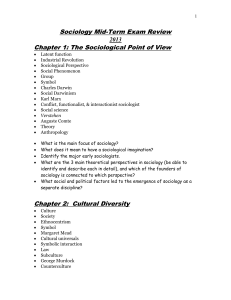SOC 339 Introduction to Crime, Law, and Deviance
advertisement

SOC339 Introduction to Crime, Law, and Deviance Instructor’s Information Purpose and Goals of Course This course is an introduction to areas of crime, law, and deviance. The goals of this course are to provide an overview of these topics, provide sufficient background for students to understand important concepts, to expose students to possible career opportunities in criminal justice or other public service, and provide students with the tools necessary to be successful in other crime, law, deviance courses. The course introduces criminology’s history, influences, and related fields of knowledge. It seeks to provide a comprehensive, balanced, and concrete overview of crime, law, and deviance. A particular focus is developed upon the criminal justice system in the United States. In so doing, the course strives to describe how the criminal justice system works, why it works that way, how it is different from past systems, how it is different from systems in other cultures, as well as how it is influenced by scientific knowledge, social norms, and prevailing beliefs about crime, criminality, and justice. The course provides a balanced critical view in that it examines strengths as well as weakness, successes as well as failures. In the big picture, crime, law, and deviance are keenly important disciplines in that it speaks directly to such issues as civil liberties, citizen rights and responsibilities, collective and individual feelings of safety and security, as well as other quality of life isues. My approach to teaching this course focuses on the scientific production of knowledge. This focus does not imply that I expect every student to become a producer of scientific knowledge. Rather, my focus on the production of scientific knowledge assumes that each and every one of us is a regular consumer of social scientific knowledge. Further, each and every one of us continually bumps up against policies and practices that have been based on social/behavioral scientific knowledge. Therefore, to be able to identify, pursue, and realize one’s self interest one must become a skilled consumer of scientific knowledge. Furthermore, the development of skills that allow one to become competent consumers of social/behavioral scientific knowledge is absolutely essential for individuals to meet their fundamental obligations as fully-engaged citizens in this information age. With the overarching objective of providing students with the tools to become better consumers of social/behavioral scientific knowledge, I have established four primary goals. Specifically, this course expects students to demonstrate an understanding of: 1) the essential vocabulary, concepts, assumptions, and theories central to crime, law, and deviance, 2) the application of the scientific method, 3) how culture, socialization, and social structure impact crime and reactions to crime, and 4) some of the key findings and interpretations of criminological knowledge. The class provides lecture, discussion, and assignments to help students learn the skills to become better consumers of social scientific knowledge. The class utilizes a series of tests to determine the degree to which students have met these expectations. Required Texts Fagin, Jame A. 2003. Criminal Justice. Boston, MA: Allyn and Bacon. Student Learning Objectives (1) To learn the essential vocabulary, concepts, assumptions, and theories central to crime, law, and deviance. (2) To understand the application of the scientific method to studying crime, law, and deviance. (3) To learn how culture, socialization, and social structure impact crime and reactions to crime. (4) To learn some of the key findings and interpretations of criminological knowledge. Teaching Objectives (1) To provide an overview of crime, law, and deviance. (2) Provide sufficient background for students to understand important concepts. (3) To expose students to possible career opportunities in criminal justice or other public service. (4) To provide students with the tools necessary to be successful in other crime, law, deviance courses. Student Responsibilities Unit Vocabulary Quizzes: There will be three unit (i.e., not comprehensive) vocabulary quizzes in-class, covering all of the key terms from the text. All of the questions will provide a definition and ask you to pick the correct term from a choice of four terms. Flashcards are helpful in preparing for vocabulary quizzes. In terms of grading, the total number correct from each quiz will be summed and then divided by the total possible number of correct answers. This percentage of the total correct will be curved. That is, the highest score in the class will serve as the 100% mark. Individual scores will be determined as a percentage of correct answers divided by high score for that quiz. Unit Exams: There will be three unit (i.e., not comprehensive) multiple choice tests in-class, surveying materials covered in the text and in-class. Each test will consist of 100 multiple choice questions. Questions will be selected from readings AND materials presented in class. Each question will have one right answer among four choices. In terms of grading, each unit exam will be curved. That is, the highest score in the class for each exam will serve as the 100% mark. Individual scores will be determined as a percentage of correct answers divided by high score for that quiz. Comprehensive Test: On final exam day, students will be given a comprehensive multiple-choice exam, sampling materials covered in the text and in-class for the entire semester. Note: the comprehensive exam is NOT limited to questions presented on the four unit exams. The comprehensive exam will consist of 200 multiple-choice questions. Each question will have one right answer among four choices. About 75% of the exam (150 questions) will come from the text and lecture) and 25% of the exam (50 questions) will come from vocabulary terms. The comprehensive exam will be curved in the following manner: the highest score in the class will serve as the 100% mark. Individual scores will be determined as a percentage of correct answers divided by the high score for the comprehensive exam. Policies and Grading Academic Honesty: Students are expected to do their own individual work always. If you are unclear as to what constitutes academic dishonesty, please refer to the Student Rights and Responsibilities Handbook (www.uky.edu/StudentAffairs/Code>). I will pursue disciplinary action for those violate academic honesty. Grading: Final course grades consist of the following course components and percentages of final grade: 15% 25% 40% 20% Attendance Percentage Score Overall Vocabulary Quiz Percentage Score Overall Unit Exam Percentage Score Comprehensive Exam Percentage Score You can calculate your grades as follows: Final Grade Percentage = (.15*Attendance %) + (.25*Vocabulary Quiz %) + (.40*Unit Exam %) + (.20*Comprehensive Exam%) If you have trouble calculating what your grade is at any point in the semester, please see me. Final Grades will be distributed as follows: A = 90% or higher B = 80% to 89% C = 70% to 79% D = 60% to 69% E = less than 60% Make-up quizzes/tests: If you have to miss a quiz or test, contact me as soon as possible. It is much better to contact me in advance of the quiz or test than afterward, if at all possible. Those who have a verifiable excused absence (see University Bulletin 20022003, p. 54, for the definition of excused absences) will be allowed to make-up quizzes or tests at no penalty. Those who missed a quiz or test due to an unexcused absence (i.e., those that are not considered excused as defined by the University Bulletin 2002-2003) will be allowed to make-up quizzes and tests at a 20% penalty. Missing a film viewing: During the course of the semester, I will show several videos. If you miss a video, you can check it out from our administrative assistant, Kim Hayden, Patterson Office Tower 1515, and view it in our departmental library. Films are available Monday through Friday from 8:00 AM to 11:00 AM and from 1:00 PM to 3:00 PM. You may check the film out for one hour. To check out a film to view in our library, you must leave Ms Hayden with a copy of your driver’s license or student identification card. Schedule (see calendar attached below) January Sun Mon Tue Wed Thu 1 4 5 6 7 8 11 12 13 14 15 Introduction 18 19 20 21 Chapter 1 25 26 27 Chapter 3 Film: Punishment 1 22 Chapter 2 28 29 Chapter 4 February Sun Mon Tue Wed Thu 1 2 3 4 5 Chapter 5 Film: Punishment 2 8 9 10 Crimes against Persons & Property 11 Vocabulary Quiz 1 15 16 17 Unit Exam 1 18 Chapter 6 22 23 24 Chapter 8 Film: Hooked 29 12 19 Chapter 7 25 26 Chapter 9 March Sun Mon Tue Wed Thu 1 2 3 4 Chapter 10 Film: The Sting 7 8 9 Drug Abuse Crimes 10 Vocabulary Quiz 2 14 15 SPRING BREAK 21 22 16 SPRING BREAK 23 Unit Exam 2 17 SPRING BREAK 24 Chapter 11 28 29 30 Chapter 13 Film: Angola 1 11 18 SPRING BREAK 25 Chapter 12 31 S B April Sun Mon Tue Wed Thu 1 Chapter 14 4 5 6 7 Chapter 15 Film: Angola 2 11 12 13 Technology & Crime 14 Film: Organized Crime 18 19 20 26 27 Review 15 White Collar Crime & Organized Crime 21 Vocabulary Quiz 3 25 8 22 Unit Exam 3 28 29 Review








